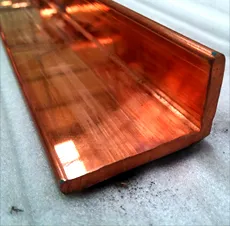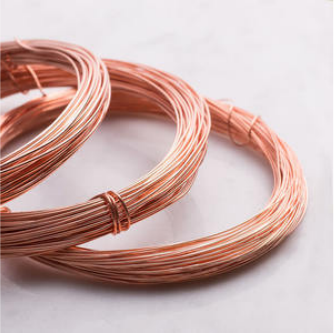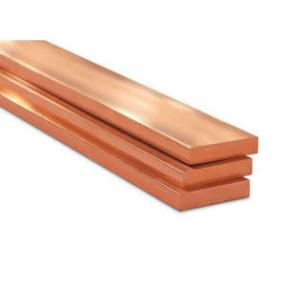1. Introduction
Copper is one of the most versatile metals in industrial and electrical applications—and copper rod is at the heart of it all. From grounding systems to welding and even scrap recycling, different forms of copper rod serve unique purposes. But not all copper rods are created equal. Whether you’re sourcing a copper earth rod for lightning protection or a copper brazing rod for joining pipes, understanding the distinctions can save time, money, and headaches.

In this deep-dive listicle, we break down seven essential types of copper rods and strips, comparing their composition, applications, pros and cons, and even pricing insights like earthing rod price or copper strip price. Let’s get into the details.
2. Copper Earth Rods vs. Copper-Bonded Alternatives
When it comes to grounding electrical systems, two main options dominate: solid copper earth rods and copper-bonded (or copper-clad) variants.
Solid earthing rod copper is made entirely of high-conductivity copper. It offers superior corrosion resistance and longevity, especially in aggressive soils. However, it’s expensive—making copper rod price a major consideration for large-scale projects.
On the flip side, copper bonded earthing rod (also called copper clad steel ground rod or copper clad earth rod) uses a steel core with a thick outer layer of copper. This design combines the tensile strength of steel with the conductivity and corrosion resistance of copper. It’s more affordable and widely used in telecom and power distribution.
- Copper bonded steel offers 90%+ of copper’s conductivity at a fraction of the cost
- Solid copper earth rods last longer in highly corrosive environments
- Earthing rod price for copper-bonded versions is typically 30–50% lower than solid copper
3. Copper Brazing and Welding Rods: What’s the Difference?
Many confuse copper brazing rods with copper welding rods—but they serve different joining processes.
Copper brazing rod is used in brazing, where a filler metal (like copper-phosphorus alloy) melts at a lower temperature than the base metals. Copper to copper brazing rods are ideal for HVAC and plumbing, especially with copper pipework. They flow easily into joints without melting the base pipe.

In contrast, copper welding rod (or copper rod for welding) is used in actual welding processes like TIG or MIG, where both base and filler metals melt. Copper to copper welding rod is rare because pure copper is hard to weld—it requires preheating and specialized techniques. Most ‘welding rod copper’ products are actually copper alloys like silicon bronze.
- Copper rod welding is challenging due to high thermal conductivity
- Copper brazing is preferred for aircon copper pipe repairs
- Always match the filler rod to your base metal—e.g., use copper-phosphorus for copper-to-copper joints
4. Round Copper Bars vs. Flat Copper Strips
While ‘copper rod’ often implies round cross-sections (also called copper round bar or round bar copper), flat forms like copper strip are equally vital.
Copper strip—sometimes misspelled as ‘copper stip’ or ‘copper stripes’—comes in rolls or straight lengths. Common sizes include 1mm copper strip or the standard copper earth strip 25x3mm. Applications range from electrical busbars to earthing systems and even decorative copper roof strip.
Flexible copper bus bar and nickel plated copper strip are used in high-performance electronics, while beryllium copper strip offers spring-like properties for connectors.
- Flat copper strip conducts better in tight spaces than round bars
- Copper strip for earthing must meet conductivity and thickness standards
- Copper strip price varies by alloy—beryllium copper strip costs significantly more
5. Stripping Copper Wire: Best Practices for Scrap and Recycling
For recyclers, stripping copper wire is a daily task. But methods matter—burning copper wire for scrap releases toxic fumes and degrades metal quality.

The best way to strip copper wire is mechanical: use a wire stripper or automated machine. For long runs, the fast way to strip copper wire involves rotary strippers. Always avoid burning—it’s illegal in many areas and reduces resale value.
When sourcing materials, phrases like ‘copper strip near me’ or ‘stripping wire for recycling’ often lead to local scrap yards. Remember: stripped, clean copper fetches the highest price per pound.
- Never burn insulation off—use mechanical stripping instead
- Stripping copper wire for scrap increases value by 20–30%
- Look for ‘roll of copper strip’ when buying in bulk for DIY projects
6. Copper Rods in HVAC: Aircon Copper Pipe Connections
Though not rods per se, copper tubing used in air conditioning systems often requires rod-like fillers for repairs. Aircon copper pipe (or ac copper pipe) is typically 15mm or 22mm in diameter and joined using copper brazing rods.
Professionals resoldering copper pipe joints rely on copper pipe soldering techniques with phosphorus-copper rods. Using the wrong filler—like aluminum-based products—can cause leaks or system failure.
Copper pipe price fluctuates with the LME copper rate, so timing purchases matters. Always verify sizing: 3/4 copper pipe isn’t the same as 22mm, despite similar appearances.
7. Pricing and Sourcing Guide
Whether you need copper bars for sale, copper ingot price benchmarks, or copper strip roll suppliers, cost depends on purity, form, and market demand.
Solid copper rod commands a premium, while copper bonded options offer budget-friendly alternatives. For earthing projects, compare copper earth strip 25x3mm price across vendors—local suppliers often beat online ‘copper strip near me’ searches on delivery speed.
Recyclers should track 1oz copper price trends to time scrap sales. And remember: flexible copper bar and copper alloy strip serve niche roles—don’t substitute unless specs allow.
8. Conclusion
From copper clad steel earth rod installations to precision copper brazing in HVAC systems, the right copper rod or strip makes all the difference. Understanding material differences—like solid vs. bonded, round vs. flat, or brazing vs. welding—ensures safety, efficiency, and cost savings. Whether you’re an electrician, plumber, or scrap dealer, knowing these seven types puts you ahead of the curve.
Our Website founded on October 17, 2012, is a high-tech enterprise committed to the research and development, production, processing, sales and technical services of ceramic relative materials such as 7. Our products includes but not limited to Boron Carbide Ceramic Products, Boron Nitride Ceramic Products, Silicon Carbide Ceramic Products, Silicon Nitride Ceramic Products, Zirconium Dioxide Ceramic Products, etc. If you are interested, please feel free to contact us.

